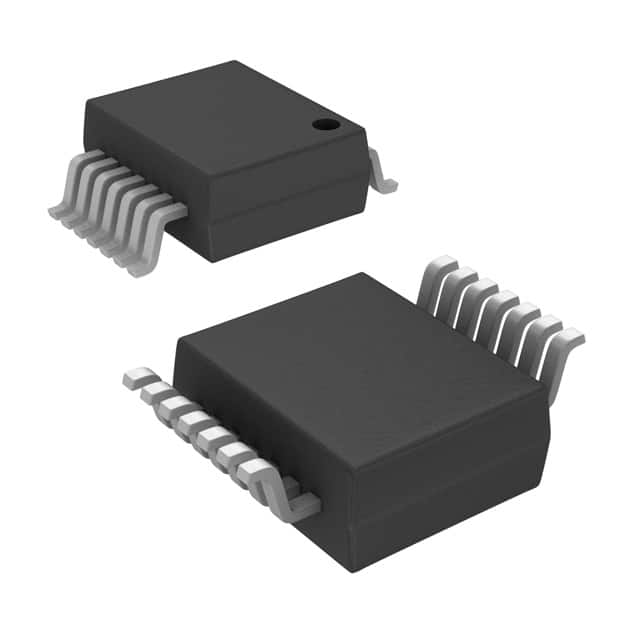Xem thông số kỹ thuật để biết chi tiết sản phẩm.

SN74AHC123ADGVR
Product Overview
- Category: Integrated Circuit (IC)
- Use: Multivibrator
- Characteristics: High-speed, low-power, monostable multivibrator
- Package: VSSOP (Very Small Outline Package)
- Essence: Flip-flop with retriggerable/resettable capability
- Packaging/Quantity: Tape and reel packaging, 2500 units per reel
Specifications
- Supply Voltage Range: 2V to 5.5V
- Operating Temperature Range: -40°C to +85°C
- Propagation Delay Time: 7 ns (typical)
- Output Current: ±8 mA
- Input Capacitance: 3.5 pF (typical)
Detailed Pin Configuration
The SN74AHC123ADGVR has a total of 16 pins. The pin configuration is as follows:
- CLR (Clear) - Active LOW input for resetting the flip-flop
- A (Trigger) - Input for triggering the flip-flop
- B (Threshold) - Input for setting the threshold voltage
- RCext (External Resistor-Capacitor) - External resistor-capacitor timing components connection
- GND (Ground) - Ground reference
- Q (Output) - Output of the flip-flop
- Q̅ (Complementary Output) - Complementary output of the flip-flop
- VCC (Supply Voltage) - Positive supply voltage
Functional Features
- Retriggerable/Resettable: The flip-flop can be reset or retriggered using the CLR input.
- Monostable Operation: The IC functions as a monostable multivibrator, producing a pulse of fixed duration upon trigger input.
- High-Speed Operation: The SN74AHC123ADGVR operates at high speeds, making it suitable for time-critical applications.
- Low Power Consumption: The IC is designed to consume low power, making it energy-efficient.
Advantages and Disadvantages
Advantages: - Retriggerable/Resettable capability provides flexibility in timing applications. - High-speed operation allows for precise timing control. - Low power consumption makes it suitable for battery-powered devices.
Disadvantages: - Limited output current may restrict its use in certain applications requiring higher current levels. - Input capacitance may affect the performance in high-frequency applications.
Working Principles
The SN74AHC123ADGVR is based on a flip-flop circuit with retriggerable/resettable functionality. Upon receiving a trigger input (A), the flip-flop changes state and produces an output pulse. The duration of the pulse is determined by the external resistor-capacitor (RCext) timing components connected to pin 4. The flip-flop can be reset using the CLR input (pin 1) or retriggered before the completion of the pulse. This allows for precise control over the timing of the output pulse.
Detailed Application Field Plans
The SN74AHC123ADGVR finds applications in various fields, including:
- Timing Circuits: The retriggerable/resettable feature makes it suitable for generating precise timing signals in applications such as clocks, timers, and frequency dividers.
- Pulse Generation: The monostable operation enables the IC to generate fixed-duration pulses used in applications like pulse-width modulation (PWM), pulse position modulation (PPM), and pulse shaping.
- Control Systems: The IC can be used in control systems where accurate timing is crucial, such as motor control, robotics, and industrial automation.
- Communication Systems: It can be employed in communication systems for generating synchronization signals, data encoding/decoding, and signal conditioning.
Detailed and Complete Alternative Models
- CD74HC123E: Similar monostable multivibrator IC with retriggerable/resettable capability. Package: PDIP (Plastic Dual-In-Line Package).
- MC74VHC123A: High-speed CMOS monostable multivibrator IC with retriggerable/resettable feature. Package: SOIC (Small Outline Integrated Circuit).
- SN74LVC123ADGVR: Low-voltage CMOS monostable multivibrator IC with retriggerable/resettable functionality. Package: VSSOP.
These alternative models offer similar functionalities to the SN74AHC123ADGVR and can be considered as substitutes based on specific requirements.
Word count: 540 words
Liệt kê 10 câu hỏi và câu trả lời thường gặp liên quan đến ứng dụng SN74AHC123ADGVR trong giải pháp kỹ thuật
Sure! Here are 10 common questions and answers related to the application of SN74AHC123ADGVR:
Q: What is SN74AHC123ADGVR? A: SN74AHC123ADGVR is a dual retriggerable monostable multivibrator (also known as a "one-shot") integrated circuit.
Q: What is the purpose of SN74AHC123ADGVR? A: It is used to generate precise time delays or pulses in various electronic circuits.
Q: What is the operating voltage range for SN74AHC123ADGVR? A: The operating voltage range is typically between 2V and 5.5V.
Q: What is the maximum output current of SN74AHC123ADGVR? A: The maximum output current is typically around 8mA.
Q: How many inputs does SN74AHC123ADGVR have? A: It has two inputs, labeled A and B.
Q: Can SN74AHC123ADGVR be used as a frequency divider? A: Yes, it can be used as a frequency divider by connecting the output of a clock signal to input A and using input B as a control signal.
Q: What is the typical propagation delay of SN74AHC123ADGVR? A: The typical propagation delay is around 9 ns.
Q: Can SN74AHC123ADGVR operate in both monostable and astable modes? A: Yes, it can operate in both modes depending on the configuration of its inputs and external components.
Q: Is SN74AHC123ADGVR suitable for high-speed applications? A: Yes, it is suitable for high-speed applications due to its low propagation delay and compatibility with AHC logic family.
Q: What are some common applications of SN74AHC123ADGVR? A: It is commonly used in timing circuits, pulse generation, frequency division, precision delay circuits, and control systems.
Please note that the answers provided here are general and may vary depending on specific datasheet specifications and application requirements.

